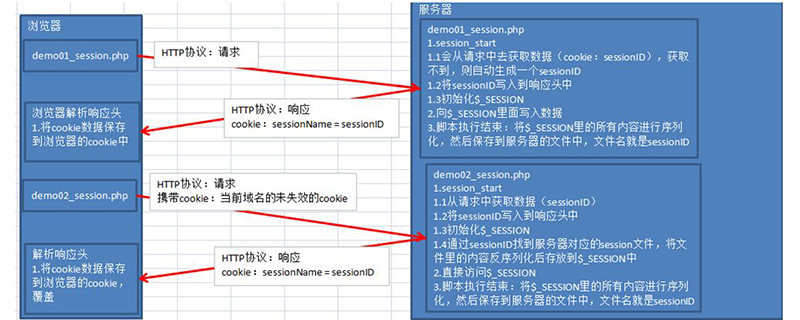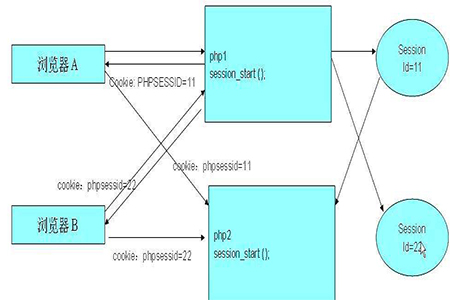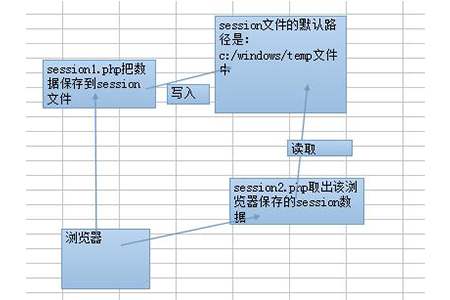How to understand the php session operating mechanism
The php session operating mechanism is that the client passes the session id to the server, and the server then finds the corresponding file based on the session id and deserializes it to get the session value, and then serializes it when saving. Transform and then write
The knowledge point I will share today is the session running mechanism in PHP. It is not unfamiliar to developers who are familiar with PHP, but it is not very understandable for those who are just getting started. Next, in the article, I will introduce the session running mechanism in PHP in detail, which has a certain reference effect. I hope it will be helpful to everyone

## [Recommended course: PHP Tutorial]
PHP session operating mechanism meaning:
PHP session operating mechanism is that the client will use the session id Passed to the server, the server finds the corresponding file according to the session id. When reading, it deserializes the file content to get the session value. When saving, it is first serialized and then written toPHP session Mechanism classification
There are two mechanisms for session in PHP, namely the default mechanism and the user-defined session processing mechanism.Default mechanism
php.ini configuration:
session.save_handler = files
session_start()
session_start() is the beginning of the session mechanism, which has a certain probability of starting garbage collection. This probability is determined based on the configuration of php.ini, because in some systems session.gc_probability = 0, that is, the probability is 0, then there is no garbage collectionAssign value to $_session
Adding a new value will only be maintained in memory. When the script execution ends, write the value of $_session to the folder specified by session_id, and then close the related resources. At this stage, it is possible to perform operations to change the session_id, such as destroying an old session_id and generating a new session_id. This is generally used in custom session operationsExample:
if (isset($_COOKIE[session_name()])) {
setcookie(session_name(),'',time() -42000,'/');//旧session cookie过期
}
session_regenerate_id();//这一步会生成新的session_id
//session_id()返回的是新的值Write session operations
Destroy session
The cookies sent by the session are generally instant cookies, which are stored in memory and will expire when the browser is closed. , but if you just want to log out instead of closing the browser, then you need to destroy the session in the code. There are many methods. Example:1. setcookie(session_name(),session_id(),time() -8000000,..);//退出登录前执行 2. usset($_SESSION);//这会删除所有的$_SESSION数据,刷新后,有COOKIE传过来,但是没有数据。 3. session_destroy();//这个作用更彻底,删除$_SESSION 删除session文件,和session_id

php.ini configuration
session.save_handler = user
Execute open( $save_path,$session_name) statement opens the session operation handle
Execute read($id) to read data from it
Note:$save_path returns true directly in this case
End of script executionExecute write($id,$sess_data) statement
Destroy sessionIt should be noted that if the user needs to destroy the session, he must first execute destroy and then execute step 2
 Summary: The above is the entire content of this article. I hope it will be helpful to everyone. .
Summary: The above is the entire content of this article. I hope it will be helpful to everyone. .
php Chinese network learning topic
The above is the detailed content of How to understand the php session operating mechanism. For more information, please follow other related articles on the PHP Chinese website!

Hot AI Tools

Undresser.AI Undress
AI-powered app for creating realistic nude photos

AI Clothes Remover
Online AI tool for removing clothes from photos.

Undress AI Tool
Undress images for free

Clothoff.io
AI clothes remover

Video Face Swap
Swap faces in any video effortlessly with our completely free AI face swap tool!

Hot Article

Hot Tools

Notepad++7.3.1
Easy-to-use and free code editor

SublimeText3 Chinese version
Chinese version, very easy to use

Zend Studio 13.0.1
Powerful PHP integrated development environment

Dreamweaver CS6
Visual web development tools

SublimeText3 Mac version
God-level code editing software (SublimeText3)

Hot Topics
 1655
1655
 14
14
 1413
1413
 52
52
 1306
1306
 25
25
 1252
1252
 29
29
 1226
1226
 24
24
 Explain JSON Web Tokens (JWT) and their use case in PHP APIs.
Apr 05, 2025 am 12:04 AM
Explain JSON Web Tokens (JWT) and their use case in PHP APIs.
Apr 05, 2025 am 12:04 AM
JWT is an open standard based on JSON, used to securely transmit information between parties, mainly for identity authentication and information exchange. 1. JWT consists of three parts: Header, Payload and Signature. 2. The working principle of JWT includes three steps: generating JWT, verifying JWT and parsing Payload. 3. When using JWT for authentication in PHP, JWT can be generated and verified, and user role and permission information can be included in advanced usage. 4. Common errors include signature verification failure, token expiration, and payload oversized. Debugging skills include using debugging tools and logging. 5. Performance optimization and best practices include using appropriate signature algorithms, setting validity periods reasonably,
 How does session hijacking work and how can you mitigate it in PHP?
Apr 06, 2025 am 12:02 AM
How does session hijacking work and how can you mitigate it in PHP?
Apr 06, 2025 am 12:02 AM
Session hijacking can be achieved through the following steps: 1. Obtain the session ID, 2. Use the session ID, 3. Keep the session active. The methods to prevent session hijacking in PHP include: 1. Use the session_regenerate_id() function to regenerate the session ID, 2. Store session data through the database, 3. Ensure that all session data is transmitted through HTTPS.
 What is REST API design principles?
Apr 04, 2025 am 12:01 AM
What is REST API design principles?
Apr 04, 2025 am 12:01 AM
RESTAPI design principles include resource definition, URI design, HTTP method usage, status code usage, version control, and HATEOAS. 1. Resources should be represented by nouns and maintained at a hierarchy. 2. HTTP methods should conform to their semantics, such as GET is used to obtain resources. 3. The status code should be used correctly, such as 404 means that the resource does not exist. 4. Version control can be implemented through URI or header. 5. HATEOAS boots client operations through links in response.
 What are anonymous classes in PHP and when might you use them?
Apr 04, 2025 am 12:02 AM
What are anonymous classes in PHP and when might you use them?
Apr 04, 2025 am 12:02 AM
The main function of anonymous classes in PHP is to create one-time objects. 1. Anonymous classes allow classes without names to be directly defined in the code, which is suitable for temporary requirements. 2. They can inherit classes or implement interfaces to increase flexibility. 3. Pay attention to performance and code readability when using it, and avoid repeatedly defining the same anonymous classes.
 How do you handle exceptions effectively in PHP (try, catch, finally, throw)?
Apr 05, 2025 am 12:03 AM
How do you handle exceptions effectively in PHP (try, catch, finally, throw)?
Apr 05, 2025 am 12:03 AM
In PHP, exception handling is achieved through the try, catch, finally, and throw keywords. 1) The try block surrounds the code that may throw exceptions; 2) The catch block handles exceptions; 3) Finally block ensures that the code is always executed; 4) throw is used to manually throw exceptions. These mechanisms help improve the robustness and maintainability of your code.
 What is the difference between include, require, include_once, require_once?
Apr 05, 2025 am 12:07 AM
What is the difference between include, require, include_once, require_once?
Apr 05, 2025 am 12:07 AM
In PHP, the difference between include, require, include_once, require_once is: 1) include generates a warning and continues to execute, 2) require generates a fatal error and stops execution, 3) include_once and require_once prevent repeated inclusions. The choice of these functions depends on the importance of the file and whether it is necessary to prevent duplicate inclusion. Rational use can improve the readability and maintainability of the code.
 Explain different error types in PHP (Notice, Warning, Fatal Error, Parse Error).
Apr 08, 2025 am 12:03 AM
Explain different error types in PHP (Notice, Warning, Fatal Error, Parse Error).
Apr 08, 2025 am 12:03 AM
There are four main error types in PHP: 1.Notice: the slightest, will not interrupt the program, such as accessing undefined variables; 2. Warning: serious than Notice, will not terminate the program, such as containing no files; 3. FatalError: the most serious, will terminate the program, such as calling no function; 4. ParseError: syntax error, will prevent the program from being executed, such as forgetting to add the end tag.
 PHP and Python: Comparing Two Popular Programming Languages
Apr 14, 2025 am 12:13 AM
PHP and Python: Comparing Two Popular Programming Languages
Apr 14, 2025 am 12:13 AM
PHP and Python each have their own advantages, and choose according to project requirements. 1.PHP is suitable for web development, especially for rapid development and maintenance of websites. 2. Python is suitable for data science, machine learning and artificial intelligence, with concise syntax and suitable for beginners.




